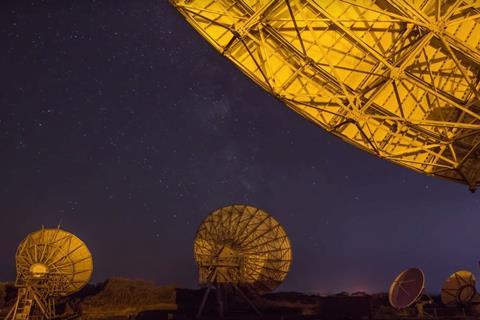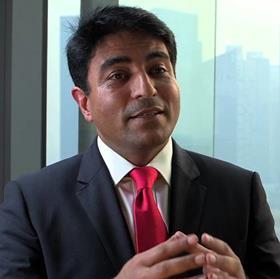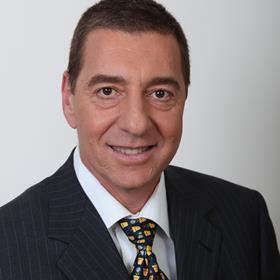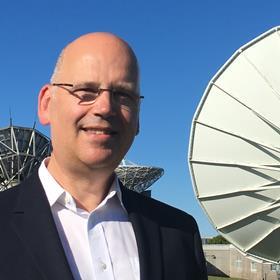It was very apparent at IBC2018 that the broadcast industry continues to be in a state of flux. Ian McMurray finds that satellite operators and suppliers are no less affected by pervasive and disruptive change.
The Telstar satellites which enabled the first intercontinental transmissions in 1962 were transformational for the broadcast industry.

Indeed, Telstar captured public imagination such that a tune recorded by The Tornados and named after the satellite was a number one hit in both the USA and the UK. The first trans-Atlantic satellite television transmission from the USA was made via Intelsat I, nicknamed ‘Early Bird’, in 1965. And, when Sky launched in 1989, we had entered a new era in which satellite established itself at the heart of broadcasting.
That today’s viewing landscape is somewhat different is, of course, a huge understatement.
“We are very much in the age of ATAWADAC - any time, anywhere, any device, any content,” smiles Michel Azibert, Deputy CEO and Chief Commercial and Development Officer at Eutelsat.
Goonhilly Earth Station CEO Ian Jones agrees. “TV habits are indeed changing,” he says. “Cord-cutting is a reality in all markets, and viewers are increasingly turning to OTT services. Broadcasters and pay-TV providers all recognise that viewers now expect to be able to watch their favourite content on the device of their choice, at home or on the move.”
And, speaking of OTT: Hans Massart, Market Director, Broadcast at Newtec, notes that, according to a recent Unisphere report, OTT viewership will overtake traditional viewing before 2020.
New opportunities
Deepak Mathur, EVP, Global Sales for SES Video develops the theme of changing viewing habits with some interesting numbers.

“The proliferation of screens in our daily lives has created new opportunities for players in the video world to capture eyeballs, throughout the course of the day, no matter where the consumer is and what device they choose to consume their content on,” he says.
“Importantly, the result of these innovations is not a massive switch to a new viewing paradigm, but rather has driven growth in overall content consumption. In the UK, for example, 291 minutes a day are being spent across viewing formats in 2018, compared with 230 minutes in 2008.
“This is precisely because the content can be consumed on the go, and in non-traditional “This is precisely because the content can be consumed on the go, and in non-traditional viewing settings. That being said, the evening remains prime time for watching video, and more than 70% of viewing time at that moment continues to be linear TV.”
It’s not just the new multi-screen, mobile, on-demand paradigm that’s challenging those in the satellite industry. As Mathur noted: content consumption is increasing in the context of a world that is becoming more Internet-centric. That has implications for bandwidth, as does the shift to higher resolutions with HD and UltraHD and improved image quality with HDR. What are satellite companies doing in response?
Although viewer habits are changing, Jacob Kerets, Senior Vice President of Sales for North America, Europe and Middle East at Spacecom points to the strength of the sector. He says: “The satellite broadcast business is resilient, with new opportunities having constantly spurred our growth for 20 years or more. Spacecom’s business model has always been – and remains – to move quickly and adeptly with new technologies so that our clients, the broadcast operators, can best provide viewers with what they want.”

Massart picks up on the challenge of bandwidth. “Growing traffic is a fundamental challenge when broadcasting popular content – especially live – to a wide audience,” he believes.
“Bandwidth needs to be used efficiently and traffic needs to be minimised. A Content Distribution Network significantly reduces traffic on the distribution backbone by storing multiple copies of the same content as close as possible to the consumer. At the same time, start latency is minimised as well as buffering of the content. Converting as much unicast transmission as possible to multicast transmission avoids sending multiple copies of the same content across the network, thus saving a huge amount of bandwidth.”
There is, it seems, something of a generational divide when it comes to viewing. For baby boomers, brought up on ‘traditional’ TV watching, linear programming is the go-to option – with on-demand and the likes of Netflix or Amazon Prime a secondary choice. It is the younger generation who have embraced the more flexible approach to content consumption. For now, at least, both need to be accommodated.
“Today, viewers tend to add OTT services on top of their linear TV,” says Mathur, “and the winning strategy for our customers is one that combines the two - offering all the benefits of top quality programmes, delivered in the highest, consistent quality in the comfort of the living room while offering the same content, anywhere, anytime on any device. To help our customers address the non-linear world, our affiliate MX1 offers media services that enable video delivery to any type of platform – allowing them to maximise their content on every screen.”
Azibert also sees the importance of offering a balance.
“We’ve expanded our business portfolio to provide complementary services - such as the recent launch of our hybrid satellite-OTT service Eutelsat CIRRUS - in order to meet the needs of our clients and end-users,” he explains. “That being said, we are not seeing a cannibalisation of OTT as there is still a hunger for live appointment television. For that kind of viewing, now more than ever, the viewer is demanding quality at the highest level, which is where transmission by satellite shines brightest.”

He goes on to note a steady increase in live viewing audience figures across the board. More than 3.4bn people - half the world’s population - watched a part of this year’s World Cup, Azibert notes. In drama, the final episode of the new BBC drama series The Bodyguard attracted a record peak of 10.4 million UK viewers. In entertainment, the Eurovision Song Contest was watched live by over 186 million viewers this year.
For Goonhilly’s Jones, such a fundamental shift in the world of content distribution and content consumption requires a no-less fundamental – radical, even - re-evaluation of how satellite companies operate.
“Today, it is no longer a case of satellite versus OTT and other distribution methods; success in today’s broadcast business depends on combining satellite and other technologies seamlessly and cost-effectively,” he says.
“These powerful market trends are encouraging satellite operators to get smarter, to ensure they play to their strengths and get stuck in and work with old ‘enemies’ and create new innovative solutions, and new business models, to help their broadcaster customers remain successful.”
Certainly, if talk on the IBC show floor was anything to go by, satellite operators are indeed re-evaluating their roles, with at least one high profile player saying that his company was now starting to think of itself less as a satellite company, and more as a communications company – with everything that entails in terms of re-imagining its business model.
“Now more than ever, the viewer is demanding quality at the highest level, which is where transmission by satellite shines brightest.” Michel Azibert, Eutelsat
That’s a concept with which Jones is in agreement – not least because he’s not sure the industry has any alternative.
“This market uncertainty is all happening just as the commercial geostationary satellite market faces huge downward pressure on capacity costs,” he continues.
“The industry is just entering the era of high-throughput satellites. New HTS spacecraft will be coming online over the next few years and these are adding even more capacity to the worldwide inventory. That means satellite operators are facing challenges on all fronts. All of these realities have inevitably made satellite and teleport operators change the way they think and the way they do business. Many incumbent service providers are struggling with falling revenues and long capacity contracts that are stifling their margins.”

Newtec’s Massart also sees cost – as well as quality and managing complexity - as key challenges.
“Efficient transmission is crucial to keep costs under control,” he believes. “Newtec has always been at the forefront of efficient satellite distribution technologies, as evidenced in our contributions to the DVB-S2X standard.”
Reducing complexity
“Another challenge for the broadcast sector is to streamline operations and differentiate from competitors on Quality of Service and Quality of Experience,” he goes on.
“CDN analytics allows a service provider to optimise its operations. Newtec Dialog, our multiservice VSAT platform, can provide the required return path for CDN analytics in the event that no other return path exists in cases where the receiver is a CPE or a redistribution site. Bi-directional communication also allows operation of digital rights management in the cloud, which reduces complexity for CPE.”
SES Video’s Mathur believes his company faces three key challenges: reach, innovation and differentiation. In response to the first, he notes SES’s launch of a number of high-powered satellites in the past 18 months to continue develop and reinforce its core video neighbourhoods across the world.
Explaining that he sees the opportunity for differentiation in the simplification and streamlining of media workflows, Mathur sees innovation as being key to addressing the growing appetite for higher image quality.
“That’s what we’re doing with projects like the US UltraHD platform, which aims to simplify the adoption of UltraHD for pay-TV operators by bringing together UltraHD content, satellite transmission, playout services, and reception equipment. By testing new technology and building systems around our customers, they can stay ahead of the curve and find new ways to monetise their content with premium offerings.”
“Satellite operators are facing challenges on all fronts” Ian Jones, Goonhilly Earth Station
Pressure on customers
“The industry is evolving so quickly,” remarks Eutelsat’s Azibert. “This puts great pressure on our customers who constantly need to invest in solutions for new features, which is where we come in. Eutelsat is striving to be the Swiss Army knife of transmission. That’s why we have been leveraging new technologies to provide a portfolio of solutions to take this burden away from our customers, thus enabling them to better serve their customer - the end-user.”
“Change is the currency of today’s - and tomorrow’s – challenges,” smiles Spacecom’s Kerets. “To meet these challenges, we’ve developed a methodology for taking advantage of new technologies. And: it’s why we are readying our HTS-enabled AMOS-17 satellite for launch in 2019 to meet the growing needs of mobile broadband Internet usage, particularly for sub-Sahara Africa.”
“We’re focused on emerging markets,” he adds. “Not only geographic, but also technology-wise. Broadband internet, backhaul, UHD are all looking exciting with HTS technology and the expanding reach of our satellites continues to maintain our strong position as a multi-regional operator.”
But: as any entrepreneur will confirm: times of change are times of challenge – but also times of opportunity, which is perhaps what has seen Goonhilly re-emerge as a player.
Agile approach
“In spite of all these dynamics and market currents - and indeed perhaps because of them - Goonhilly sees major potential for disruption,” says Jones. “We didn’t start with incumbent baggage of an existing broadcast business. We don’t have falling broadcast revenues. We don’t have excess capacity on our books - and we have no financial pressures to cut back. Instead, we only see scope for growth in broadcast - and we plan to leverage our unique position in the marketplace to play a significant role in this sector.

“Thanks to the diversity of our infrastructure resources, and to our independence and nimbleness, we are adopting an agile approach to developing and delivering solutions that challenge the traditional models.”
For all the challenges that the industry faces, Newtec’s Massart is clear that satellite – which he characterises as a “traditionally overlooked solution” – has benefits that will ensure that the industry remains not only relevant, but that will see it continue to thrive.
“Satellite delivers content efficiently over a vast geographical area,” he notes. “It can be cost-effectively scaled to a growing population of receivers. It addresses increasing resolutions and bitrates of content. It can be easily scaled to address more content. It is available to remote sites when no other communication path is possible. And it can be used to offload congested terrestrial backbones.”
Those are some compelling advantages. If the pace of change in UK TV over the second half of the 20th century could accurately be described as glacial, the first half of the 21st century will be substantially different. That will, in no small part, be thanks to the satellite industry.
























No comments yet